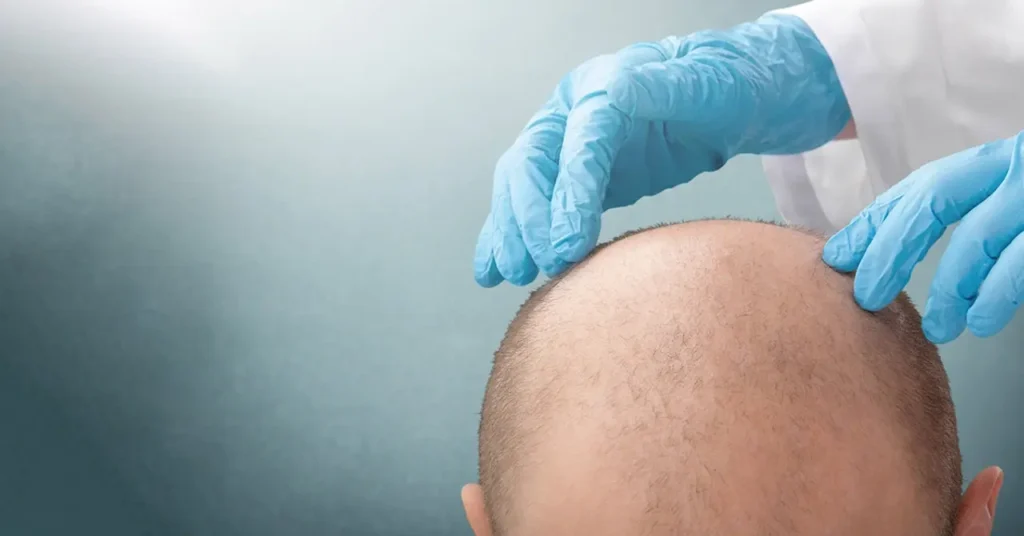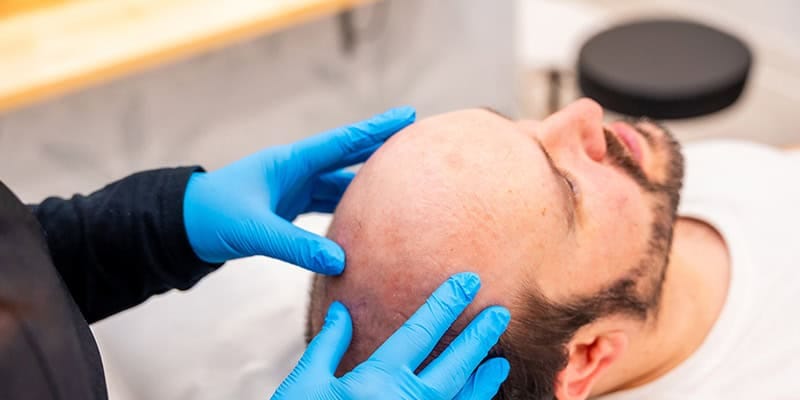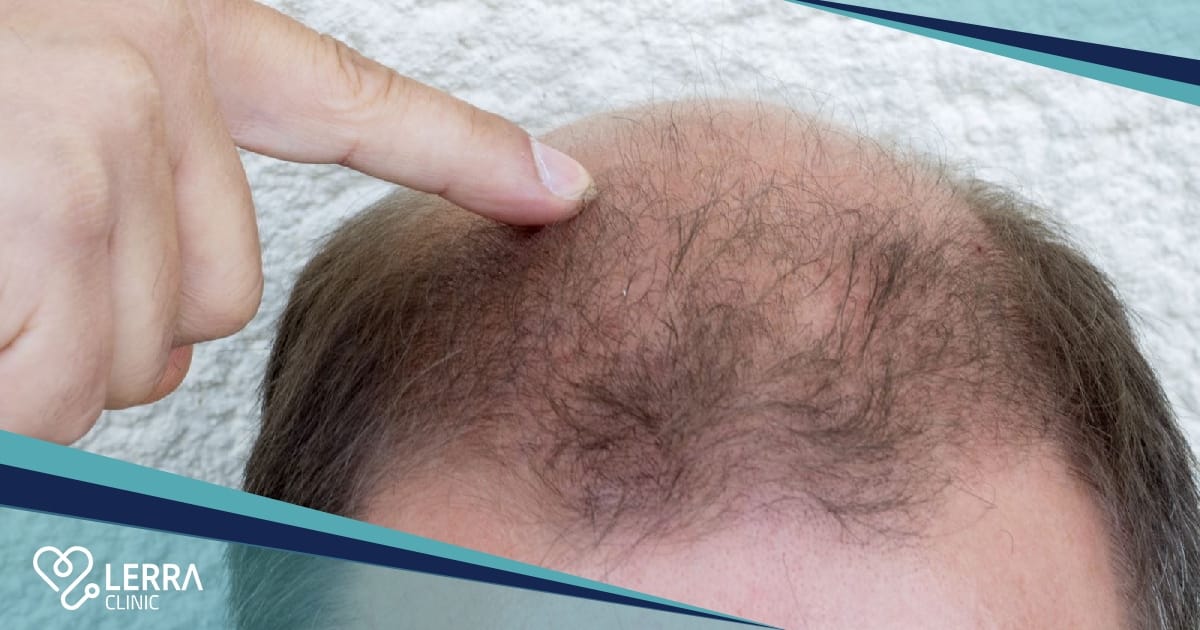If you’re thinking about getting a hair transplant, knowing what it will cost is important. Prices vary based on where you live, the clinic’s reputation, how experienced the surgeon is, and the type of procedure you choose. In this article, we’ll break down these factors and offer transparent pricing: understanding the costs of hair transplantation to help you understand the true costs involved.
Table of Contents
Key Takeaways
- Hair transplant costs are influenced by geographic location, clinic reputation, surgeon expertise, and the type of procedure chosen, with significant variations across different regions.
- A detailed cost breakdown includes consultation fees, cost per graft, and additional treatments or aftercare, aiding patients in their financial planning for hair restoration.
- Financing options, such as payment plans and understanding insurance coverage, enhance accessibility to hair transplant procedures for a broader audience.
Factors Influencing Hair Transplant Costs

Several factors influence the cost of hair transplants, making each person’s experience unique. Geographic location plays a significant role, with prices varying widely between urban and rural areas. The reputation of the clinic and the expertise of the surgeon also significantly impact costs, as highly regarded clinics and experienced surgeons tend to charge more for their services.
Additionally, the type of hair transplant procedure chosen, such as FUE (Follicular Unit Extraction) or FUT (Follicular Unit Transplantation), can affect the overall expense. Understanding these factors is crucial for anyone considering hair restoration surgery.
Geographic Location
Geographic location is a primary factor affecting hair transplant costs. Urban centers, often home to advanced medical facilities and highly skilled surgeons, tend to have higher prices compared to rural areas. For example, hair transplant costs in Turkey are significantly lower than in the USA or Europe.
This variation is due to differences in operational costs, local economic conditions, and the availability of skilled professionals. Therefore, where you undergo the procedure significantly impacts the total cost.
Clinic Reputation and Surgeon Expertise
Clinic reputation and surgeon expertise significantly influence hair transplant costs. Clinics with a proven track record of successful hair transplants and highly qualified surgeons generally charge higher rates. Experienced surgeons, often board-certified in plastic surgery or cosmetic procedures, bring a level of expertise and success rate that can justify the higher costs.
Reputable clinics provide a safer environment, superior post-operative care, and higher chances of achieving desired results, making them a worthwhile investment.
Type of Hair Transplant Procedure
The type of hair transplant procedure chosen also affects the overall cost. Follicular unit extraction fue is generally more expensive than FUT (Follicular Unit Transplantation) due to its minimally invasive nature and the precision required. An FUE procedure in the UK might cost around £5 per graft, totaling £10,000 or more for extensive treatments.
Advanced techniques like Neograft, an automated version of FUE, can further increase the cost due to the complexity and technology involved. Therefore, the method selected can significantly impact the price of a hair transplant.
Detailed Breakdown of Hair Transplant Costs
Understanding the detailed breakdown of hair transplant costs is essential for budgeting and financial planning. The total cost typically includes consultation fees, the cost per graft, and any additional treatments or aftercare services. These elements together determine the final price, which can vary based on the degree of hair loss and the number of grafts required.
Analyzing these components helps prospective patients understand what to expect financially.
Consultation Fees
Consultation fees are the first step in the hair transplant journey and can vary widely among clinics. Some clinics incorporate the consultation fee into the overall treatment cost, while others charge it separately. This fee is crucial as it covers the initial evaluation and discussion of treatment options with the surgeon.
Knowing how these fees are structured helps patients prepare for the financial commitment of a hair transplant.
Cost Per Graft
Hair transplant costs are typically quoted per graft, with the price varying depending on the clinic, surgeon, and technique used. In the USA, the average cost per graft ranges from $2 to $10, while in countries like Turkey, it can be as low as €0.55 to €2.50 per graft. More extensive hair loss requires more grafts, which increases the total cost of the procedure. For instance, a procedure involving 5,000 grafts in Turkey might cost between €2,750 and €12,500, making it a cost-effective option compared to other regions.
Robotic hair transplants and other advanced techniques may incur higher costs due to the involvement of sophisticated technology. For example, the ARTAS robotic system can significantly increase the price per graft due to its precision and efficiency. These insights help patients choose the most suitable and affordable option for their needs.
Additional Treatments and Aftercare
Additional treatments and aftercare services are vital components of the overall cost of a hair transplant surgery. These can include pre-operative tests, medications, and post-operative care to ensure optimal healing and results.
For instance, supplementary treatments like PRP (Platelet-Rich Plasma) therapy can enhance hair growth but also add to the total expense. Awareness of these additional costs is vital for accurate financial planning and achieving optimal outcomes.
Comparing Costs Across Different Regions
Hair transplant costs vary significantly across different regions, influenced by factors such as local economic conditions, operational costs, and the availability of skilled professionals. Comparing these costs can help patients make informed decisions about where to undergo their procedure.
Whether considering the USA, Canada, Europe, or Asia, understanding the regional price differences is essential for finding the most cost-effective and suitable option.
USA and Canada
In the USA, the cost of hair transplants ranges widely depending on the number of grafts and the type of procedure. For example, a hair transplant involving 2000 grafts can cost between $7,000 and $10,000. More extensive procedures with 5000 grafts can range from $10,000 to $50,000. The cost per graft typically falls between $2 and $10, depending on the clinic and surgeon’s expertise. In Canada, the average cost per graft ranges from CA$2.50 to CA$7.00, with total costs for larger procedures reaching up to CA$16,000. These figures highlight the significant investment required for hair restoration in North America.
Robotic or automated surgery methods, such as the ARTAS system, can further increase costs due to the advanced technology involved. For instance, the cost range for an ARTAS hair transplant is between $7,000 and $18,000. Understanding these regional costs and technological influences can help patients budget effectively for their hair restoration journey.
Europe
Europe presents a diverse range of hair transplant costs, with significant differences between countries. In the UK, hair transplant costs typically range from £8,000 to £12,000, depending on the number of grafts and the clinic’s reputation. Conversely, in Turkey, costs can be up to 65% lower, making it a popular destination for many seeking affordable hair restoration. For instance, a 5,000-graft procedure in Turkey might cost between €2,750 and €12,500, including comprehensive services like post-operative care and accommodation. These variations highlight the importance of considering multiple regions to find the best balance of quality and affordability.
The significant price differences across Europe make it essential for patients to thoroughly research and compare options. While the UK offers advanced medical facilities and experienced surgeons, Turkey provides a more cost-effective solution without compromising on quality. This regional comparison can guide patients in making informed decisions about their hair transplant procedures.
Asia and Other Regions
In Asia, hair transplant costs can vary widely, with countries like Turkey offering highly competitive prices. For example, a 5,000-graft hair transplant in Turkey ranges from €2,750 to €12,500, making it one of the most cost-effective options globally. The global cost for hair transplant grafts can range from $0.55 to $9.50, depending on the country and clinic. These variations are due to differences in economic conditions, operational costs, and surgeon availability.
Other regions, including parts of Asia, offer affordable hair transplant options due to lower operational costs and competitive pricing. This makes them attractive destinations for patients seeking high-quality hair restoration at a lower price.
These global cost variations assist patients in finding the most suitable and affordable options.
Financing Options for Hair Transplants
Financing options are available to help patients manage the costs associated with hair transplants and transplanted hair. Many clinics offer flexible payment plans and partner with third-party lenders to provide financing solutions.
Additionally, understanding insurance coverage and its limitations can help patients explore all available options for funding their hair restoration procedures. These financing solutions make hair transplants more accessible to a broader range of patients.
Payment Plans and Loans
Payment plans and loans are common financing options for hair transplants. Clinics often partner with third-party lenders to offer payment plans that allow patients to spread the cost over several months or years. For example, CareCredit provides promotional financing options with no interest if paid within a specified period. Patients can select plans from 24 to 60 months, with monthly payments ranging from $70 to $300, depending on the financing amount and terms. These options ease the financial burden of hair restoration.
Flexible payment plans offered by clinics can also help patients afford their hair transplant procedures. Most patients end up paying between $150 and $350 monthly when financing their hair restoration. These plans provide a more manageable way to cover the cost of the procedure, making hair transplants accessible to a wider audience.
Insurance Coverage
Insurance coverage for hair transplants is typically limited, as most procedures are considered cosmetic. However, insurance may cover hair transplants if hair loss is due to trauma or burns. In cases where hair loss results from a medical condition or injury, it’s essential to check with the insurance provider to understand the insurance cover hair transplants options.
Exploring these exceptions can help patients find potential financial support, despite general insurance exclusions for hair transplants.
Choosing the Right Clinic and Surgeon

Choosing the right clinic and surgeon is critical for ensuring a successful hair transplant. Factors such as clinic reputation, surgeon qualifications, and patient reviews play a significant role in this decision. Thoroughly researching these aspects can help patients make informed choices and achieve the best possible outcomes from their hair restoration surgery.
Researching Clinics
Researching clinics is a crucial step in the hair transplant process. Prospective patients should focus on clinic reputation and surgeon qualifications to ensure effective and minimally invasive procedures. Comparing multiple clinics and their offerings can provide valuable insights into the best options available.
Modern techniques like FUE and FUT are essential indicators of a clinic’s capabilities and commitment to quality. Thorough research helps patients make informed decisions and select the best clinic for their needs.
Evaluating Surgeons
Evaluating the surgeon’s experience and expertise is fundamental to achieving a successful hair transplant. A skilled surgeon should have at least seven years of hair transplant experience and ongoing education in the latest techniques. They should consider individual factors such as the patient’s age and medical history to tailor the procedure for the best cosmetic results. Ensuring the clinic is licensed and accredited is crucial for transparency and trustworthiness.
Reading patient reviews can provide additional insights into the quality of the surgeon and clinic. Reviews highlight common complaints or satisfaction levels, offering a glimpse into the patient experience.
Personalized consultations indicate a surgeon’s commitment to addressing specific needs, ensuring thorough preoperative counseling and follow-up for optimal outcomes.
Enhancing Hair Transplant Results with Additional Treatments
Enhancing hair transplant results with additional treatments can significantly improve the overall success and satisfaction of the procedure. Treatments like Minoxidil, Finasteride, and PRP therapy are commonly used to promote hair growth and prevent further hair loss.
While these treatments can increase the overall expense, they are often worth the investment for superior outcomes. Understanding these options allows patients to make informed decisions about their hair restoration journey.
Minoxidil and Finasteride
Minoxidil and Finasteride are two FDA-approved treatments widely used to support hair transplant results. Minoxidil increases blood flow to the scalp, promoting hair growth, and should be applied once or twice a day. It’s available in concentrations of 2 percent and 5 percent.
Finasteride works by blocking DHT, a hormone that causes hair loss, thus protecting both transplanted and existing hair. Using these treatments can significantly enhance hair regrowth and prevent further thinning, making them valuable additions to the hair restoration process.
Platelet-Rich Plasma (PRP) Therapy
PRP therapy is an innovative treatment that uses components from the patient’s own blood to enhance healing and stimulate hair growth. When combined with hair transplant procedures, PRP therapy can significantly improve results by promoting faster recovery and healthier hair growth. This treatment involves injecting concentrated platelets into the scalp, which releases growth factors that aid in tissue repair and hair follicle rejuvenation.
The inclusion of PRP therapy can be a valuable addition to the hair restoration process, enhancing the overall success of the procedure.
Potential Risks and Side Effects
While hair transplants are generally safe, they come with potential risks and side effects. It’s essential to understand these to make an informed decision and take necessary precautions. Common side effects include swelling, numbness, and temporary physical reactions in the transplant area. More severe complications, though rare, can include infections, chronic pain, and bleeding.
Assessing the clinic’s sterilization practices and hygiene standards can help minimize these risks and ensure a smoother recovery.
Common Side Effects
Common side effects of hair transplants include swelling in the transplant area, which affects about 5 percent of patients. Numbness of the scalp can also occur temporarily. These side effects are usually transient and resolve on their own with proper care.
Understanding these common reactions helps patients prepare for the post-surgery recovery phase and manage their expectations accordingly.
Rare Complications
Rare complications, though uncommon, can occur during hair transplant procedures. These include necrosis of the recipient area, which typically results from technical errors, and keloid formation, where excessive scar tissue develops during the healing process. Infection rates are low but can be mitigated by maintaining strict aseptic techniques.
Temporary cysts may also form under the skin following hair follicle transplantation. Additionally, there is a small chance of thinning in the donor area due to excessive extraction of hair follicles.
Being aware of these rare complications and choosing a reputable clinic can help reduce the risk of such outcomes.
Alternative Hair Loss Treatments
Alternative hair loss treatments offer additional options for those who may not be suitable candidates for hair transplants or who seek non-surgical solutions. These treatments range from over-the-counter solutions to advanced medical procedures like Low-Level Laser Therapy (LLLT) and hair transplantation.
Exploring these alternatives can help individuals find the most effective and suitable treatment for their hair loss condition, providing more avenues for restoring hair and confidence.
Over-the-Counter Solutions
Over-the-counter solutions like Minoxidil are effective for reducing hair thinning and promoting growth. Available in various forms, including liquid, foam, and shampoo, Minoxidil should be applied consistently for at least six months to see noticeable results.
These solutions are accessible and can be a beneficial part of a comprehensive treat hair loss treatment plan.
Low-Level Laser Therapy
Low-Level Laser Therapy (LLLT) is an FDA-approved treatment option for hair loss. Devices such as laser hair combs, brushes, hats, and helmets use red light to enhance blood flow and stimulate hair follicles, promoting hair growth.
Studies indicate that LLLT can improve hair density and overall hair health, making it a viable alternative for those seeking non-invasive hair loss treatments.
What’s the Average Cost of a Hair Transplant?
The average cost of a hair transplant varies widely depending on the location and the specifics of the procedure. In popular destinations like Turkey, prices average around £2,700 for a comprehensive hair transplant package, which often includes post-operative care, accommodation, and transfers. This makes Turkey a cost-effective option compared to other regions such as the USA and Europe.
Understanding these average costs helps patients budget effectively and choose the best option for their needs.
Summary
Understanding the costs associated with hair transplants involves considering various factors like geographic location, clinic reputation, surgeon expertise, and the type of procedure. Detailed breakdowns of consultation fees, cost per graft, and additional treatments provide a clearer picture of the total expense. Comparing costs across different regions and exploring financing options can help make hair transplants more accessible. Choosing the right clinic and surgeon, along with enhancing results through additional treatments, ensures a successful outcome. By being well-informed, patients can make confident decisions and achieve their desired hair restoration goals.
Contact us today and get the best offer!
Read Also:
Sapphire Hair Transplant Turkey
Top FUT Hair Transplant in Turkey
Frequently Asked Questions
How much will my hair transplant cost?
The cost of a hair transplant typically ranges from $6,000 to $12,000, though it can be as low as $3,000 or exceed $15,000 depending on various factors such as the procedure type and surgeon’s fees. Therefore, it is essential to consider these variables when budgeting for the surgery.
What determines hair transplant cost?
The cost of a hair transplant is primarily determined by the surgeon’s experience, the number of grafts required, the technique employed, and whether the procedure is planned as a single stage or multiple stages. Understanding these factors can help you anticipate the overall expense of the treatment.
Are hair transplants covered by insurance?
Hair transplants are typically not covered by insurance, except in cases where hair loss results from trauma or burns. Therefore, it is essential to review your insurance policy for specific coverage details.
What are the common side effects of hair transplants?
Common side effects of hair transplants include swelling, numbness, and temporary physical reactions in the transplant area. These effects are usually mild and subside with time.
Can additional treatments enhance the results of a hair transplant?
Additional treatments such as Minoxidil, Finasteride, and PRP therapy can enhance the results of a hair transplant by promoting hair growth and improving overall hair health. Employing these strategies can lead to more satisfactory and sustained results.

